Process for Manufacturing Soluble and Functional Plant Proteins, Products Obtained and Uses
a technology of plant proteins and soluble proteins, applied in the field of process for manufacturing soluble and functional plant proteins, can solve the problems of increasing cancers and cardiovascular diseases, animal proteins have numerous disadvantages, and total unfolding of molecules, and achieves good water solubility, good functional properties, and high protein content.
- Summary
- Abstract
- Description
- Claims
- Application Information
AI Technical Summary
Benefits of technology
Problems solved by technology
Method used
Image
Examples
example 1
Preparation of Soluble and Functional Pea Proteins According to the Invention
[0152]Pea flour is prepared by grinding shelled fodder peas on an Alpine hammer mill equipped with a 100 μm grille.
[0153]300 kg of flour containing 87% solids are then soaked in water to a final concentration of 25% on a dry basis, at a pH of 6.5.
[0154]1044 kg of flour suspension containing 25% solids (i.e. thus 261 kg of dry flour) are then introduced with 500 kg of water into a hydrocyclone battery composed of 14 stages. It is fed with the flour suspension at stage No. 5.
[0155]This separation leads to the production of a light phase that corresponds to the output of stage No. 1. It consists of the mixture of proteins, internal fibre and soluble matter.
[0156]This light phase at the hydrocyclone outlet contains as a mixture (142 kg on a dry basis in total): fibre (about 14.8% by weight, i.e. 21 kg dry), protein (about 42.8% by weight, i.e. 60.8 kg dry) and soluble matter (about 42.4% by weight, i.e. 60.2 kg...
example 2
Preparation of Soluble and Functional Potato Protein According to the Invention
[0167]100 kg of potatoes are cleaned and grated on Nivoba brand rasps.
[0168]The grated potato is suspended in 10 kg of drinking water.
[0169]85 kg of red water is extracted from the mixture of grated potato and water on Westfalia centrifugal decanters, said red water having a solids content of 4.5% and a protein content of about 55%.
[0170]The protein contained in the red water is flocculated to its isoelectric point by adjusting the red water to a pH of 5 by adding hydrochloric acid (37%).
[0171]The protein is extracted in a Westfalia centrifugal decanter.
[0172]1.14 kg of pure protein is obtained, which is resuspended in water so as to obtain a protein extract containing 35% solids and a protein content of 85% (N6.25).
[0173]The pH of the protein extract is rectified to a value of 7.0 by adding sodium hydroxide.
[0174]The protein extract thus obtained is subjected to a heat treatment of 125° C. for 0.8 s in a...
example 3
Comparative Example Before / after Heat Treatment (Pea Protein)
[0177]Pea protein SF, in accordance with the invention and prepared by applying the process described in Example 1 is compared, in Table I, with pea protein that has not been subjected to the functionalization process according to the invention (control s).
TABLE ISSFFlocculation 50 50temperatureRectified pH 6.6 6.6Infuser— 122temperatureFlash— 45.5coolingtemperatureSolubility 55.0 54.9(% / dry)Tg gel 141 8 300Gel 4° C. 4 000 44 000Gel 75° C.32 000 370 000Gel 120° C.200 000 720 000Tg emulsion40 0001 000 000Emulsion 4° C.74 0001 000 000Emulsion100 000 1 000 00075° C.Emulsion150 000 280 000120° C.EC (%) 64.0 70.7
[0178]The SF pea protein in accordance with the invention shows better water solubility according to test A (percentage of solubility relative to the dry weight) and gel capacity (“Gel”) measured according to test D that is higher, both at room temperature (Tg i.e. at 20° C.±2° C.) a...
PUM
 Login to View More
Login to View More Abstract
Description
Claims
Application Information
 Login to View More
Login to View More - R&D
- Intellectual Property
- Life Sciences
- Materials
- Tech Scout
- Unparalleled Data Quality
- Higher Quality Content
- 60% Fewer Hallucinations
Browse by: Latest US Patents, China's latest patents, Technical Efficacy Thesaurus, Application Domain, Technology Topic, Popular Technical Reports.
© 2025 PatSnap. All rights reserved.Legal|Privacy policy|Modern Slavery Act Transparency Statement|Sitemap|About US| Contact US: help@patsnap.com



